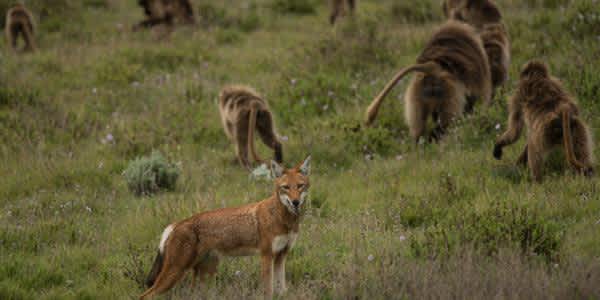Did These Monkeys Turn Wolves into Guard Animals?
OutdoorHub Reporters 06.18.15

How did one group of gelada baboons in Ethiopia manage to live peacefully with African wolves, a predator not unlike the wild dogs that usually prey on the monkeys? That is a question that many scientists have asked, and a new study in the Journal of Mammalogy has shed more light on a strange behavior that researchers have been observing for years.
“You can have a wolf and a gelada within a metre or two of each other and virtually ignoring each other for up to 2 hours at a time,” co-author Vivek Venkataraman told New Scientist.
The scientists noted that packs of Ethiopian wolves would comb through gelada groups and neither species would interact with one another. Although baby baboons would make for a tasty snack for the wolves, researchers recounted only one attack—which resulted in the wolf being promptly driven off and ostracized from the group. So have these baboons learned to “tame” wolves as a deterrent to other predators?
Surprisingly, scientists say it might actually be the other way around.
The wolves seem to be using the baboons to flush small rodents from their hiding holes, at which point the predators get an easy snack. The rodents of the Ethiopian highlands will usually stay hidden if they see a wolf, but since they do not recognize the geladas as a danger, they can be caught off-guard. In turn, since the wolves do not attack the baboons, the monkeys do not mind their presence either. In essence, the wolves are using the monkeys like a mobile hunter’s hide.
How do the gelada baboons benefit from this arrangement? Scientists say they are still unsure. The wolves do not appear to have much of an effect in driving off predators and researchers saw multiple cases of feral dogs carrying off geladas while a wolf pack was present. While having the wolves nearby may offset depredation by a slight amount, it is also possible that the baboons simply have nothing to gain from the wolves. This is in stark contrast to humanity’s own history with wolves.
Some scientists believe that humans first domesticated wolves around 40,000 years ago when the canines began following hunters after large harvests. Eventually, humans saw the benefit in keeping wolves around and used them as guard animals or even hunting companions. These tame wolves eventually became the modern dog breeds we know and love, yet scientists suspect that happened in part because humans, as omnivores, were able to dominate wolves in ways that plant-eating primates could not.
To be fair, gelada baboons can be plenty fierce, as this photo by study co-author Jeff Kerby shows:
Posted by Jeff Kerby on Friday, March 23, 2012

